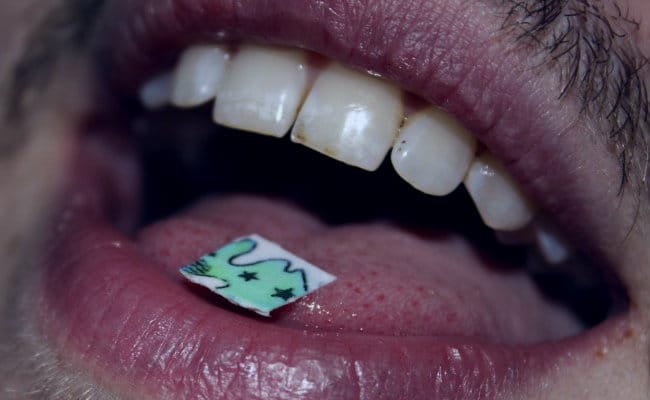There are many types of legal and illegal drugs in the world, some of which are used in medicine and others recreationally (or both, as is the case with marijuana). Among illegal and recreational drugs we can find the LSD o acid (as it is also popularly known), of which we will explain what it is, its history, how it is used and what its effects are.
Learn what LSD is
The scientific name is lysergic acid diethylamide, although it is better known under the name of LSD, lysergic or acid, as we mentioned earlier. This is a psychedelic drug, which can be obtained through the family of “tryptamines” and “ergoline”. Its form of use is recreational and produces a series of psychological effects that we will see later.
It is one of the most popular illegal and recreational substances, despite belonging to the category of hard drugs or powerful. Its effects can be incredibly strong in really low amounts, since unlike drugs, LSD uses the unit "micrograms" as its measure; while the former usually use milligrams.
Acid characteristics
- Despite the myths and false beliefs in the population, it is proven LSD does not cause dependence, at least not physically. This is because it is very easy to become tolerant to it, which prevents it from being consumed excessively.
- To achieve effects in a human, the minimum amount of lysergic acid that can be used is around 24 micrograms; as it also depends on the person in question.
- LSD has no smell, color, or taste. In addition, it is sensitive to moisture and light.
What is the history of LSD or lysergida?

This drug is extremely popular because of the history of its creation, as the scientist who discovered it did not realize its discovery until he accidentally dosed himself and had a host of psychedelic effects on his journey home. Below you will have a brief summary about its history.
LSD was synthesized in 1938 by Albert Hofmann, a Swiss chemist who was working on research that aimed to analyze the alkaloids of the group ergoline. When he started working with different amide derivatives of the acid, he came across LSD-25 (lysergic acid diethylamide), which Hofmann wanted to use to treat health problems. However, this did not cause any positive effect on the animals beyond altering them; reason why the investigation was abandoned.
Five years later, in 1943, Hofmann decided to resynthesize LSD-25 so that he could study it more deeply. In these studies the chemical was dosed accidentally, feeling effects such as dizziness and a state quite similar to when we are drunk, which intensified when he lay down.
This discovery made him consider the idea of consuming a higher dose in order to determine what its effects were in humans. The experiment later became a celebration and the day of the test was renamed "The day of the bicycle ”, which was on April 19, 1943.
On that date, Hoffman consumed 250 micrograms of LSD, unaware that this amount was a high dose. Due to its strong effects, he decided to cycle home with his assistant, a journey that he later described to truly mind-blowing effects.
What is the clinical, spiritual and recreational use of LSD?
LSD was used for several years not only recreationally, but also medically and spiritually. However, its clinical uses were banned in the United States in 1962, although studies were still possible until 1966, in which possession of the substance became a misdemeanor.
a) Clinical uses of the acid
- Among the first tests in humans were experiments in healthy people to understand what effects the drug caused.
- Several psychoanalysts and psyche therapists used LSD so that patients could accept and face their fears or repressions.
- Acid was used in alcoholics to test the effect it had on them, resulting in more than half of the patients giving up alcohol completely or significantly reducing consumption.
- The compound was also used in people with serious illnesses such as cancer, obtaining positive results in relieving pain, for example.
- Autistic children were tested as were schizophrenics, achieving under the effects that they had more interest in relating to people.

b) Spiritual uses of lysergic acid
Due to its powerful effects on the psyche and consciousness of individuals, LSD is used spiritually since it is within the group of entheogens, which is nothing more than a substance capable of modifying consciousness.
c) Recreational uses
Like other recreational drugs, LSD is used by people for entertainment and leisure. Although it is not recommended, this drug is used for parties, as well as gatherings of friends.
How to consume LSD or lysergic acid
LSD can be consumed in different ways and through different means. Among the most common methods of consumption, we find the oral route through the use of blotting paper, sugar cube or gelatin with the substance; while it is also possible to dose it cutaneously, intravenously or intramuscularly. In some countries like Spain, it is possible to get droppers with LSD to use the substance over another (such as gelatin) and dose.
The price can vary considerably depending on the country where you are, in addition, it is difficult to find LSD in its pure state; as manufacturers look for ways to circumvent the law by creating similar compounds; such as NBOME, which although it produces effects similar to that of acid, is an experimental drug that has not had enough studies for a safe or responsible consumption.
What are the effects of LSD?

LSD has cognitive psychological effects, sensory and perceptual; in addition to affecting the mood, some behaviors and more. It should be noted that the effects that will be mentioned below are those that occur when an individual ingests LSD.
The psychological effects of LSD they are one of the reasons why psychoanalysts and psychotherapists took a great interest in the substance. These effects can vary from person to person, as everyone has their own thoughts. In addition, the "trip" may vary depending on the place or environment where it is consumed and how the person feels.
- The most common cognitive effect is that this substance achieves a stimulation in the thought processes, causing that many ideas can be had in a short period of time. Although it can be a problem on some occasions; the opposite is true when doing recreational activities, for example.
- The sensory effects generate more sensitivity in hearing and sight, in addition to producing synesthesia.
- The most common perceptual effect is that people on LSD lose track of time (they also lose interest in it).
- The individuals who ingest LSD They present effects on behavior, because they are more susceptible, they can have negative thoughts regarding interpersonal relationships, that is, they are capable of feeling ignored, for example.
- The mood is also affected, since the person is very susceptible and can go from euphoria to sadness in a short time. In some people it can cause anxiety; while in others LSD can calm her down.
- Finally, there are also LSD effects that produce philosophical, spiritual and religious thoughts; since people usually think about their existence, they feel united with everything that surrounds them and they have the feeling of understanding the why of everything.